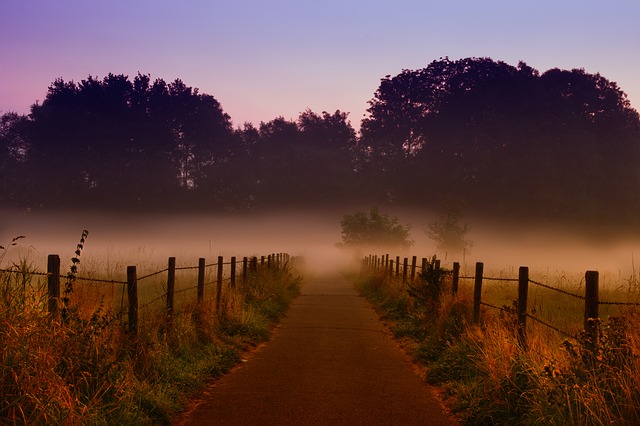Of Dawn & Dusk, Beginnings & Endings

Wait for it. Dawn creeps along the horizon. The coming day is foretold with growing light, long before the sun’s disk crests the horizon. Like a saga of history – an event long looming on time’s horizon, then bursting suddenly into a new day, new period of happenings.
Finally, after a long hours of busyness or tiresome monotony, fulfilled or broken goals, fights and loves, the sun drops toward the horizon again. A different horizon this time, signaling that the day is ended and there will be no turning back. Like the ending of a past era, light slips away. Not all at once, but steadily. Until, in the darkness, we wonder if it is all over so soon.
Dawn and dusk. Beginnings and endings. Every year on the week of April 12th, I pull out some primary sources. Sometimes, I mix old favorites with new sources, but I like to read an account about the beginning of the Civil War and the ending of the conflict.
On April 12, 1861, a long simmering conflict burst into cannon blasts when the Rebel Confederates opened fire on Fort Sumter in Charleston Harbor. On April 12, 1865, the remaining troops of the Army of Northern Virginia laid down their weapons in a formal act of surrender. No, April 12 and the war’s end for the Army of Northern Virginia did not automatically end the conflict – other battles and surrenders were still ahead on the 1865 timeline, but it did mark a major ending.
This year Mary Chesnut’s words took me to the rooms and rooftops of civilian Charleston on that fateful morning. Her almost stream of consciousness style gives an impression of experiencing the moments before sunrise as the cannons fired, shells lit up the sky, and the sun rose on an American continent that would never be the same again.
For a look at Appomattox happenings, General Joshua L. Chamberlain offers some of the best writing. Perhaps stylized, perhaps at times in conflict with facts and memory, his records still show the moments of surrender. The story of his orders and the “last salute” are well-known, so I chose to focus on his descriptions as the surrender day worn on. There, in the dusky evening, the final flames of armed rebellion in that place burned out, literally.
In memory of the historic anniversaries today, here are excerpts from my recent reading:
Mary Chesnut – April 12, 1861
I do not pretend to go to sleep. How can I? If Anderson does not accept terms – at four – the orders are – he shall be fired upon.
I count four – St. Michael chimes. I begin to hope. At half-past four, the heavy booming of a cannon.
I sprang out of bed. And on my knees – prostrate – I prayed as I never prayed before.
There was sound of stir all over the house – pattering of feet in the corridor – all seemed to be hurrying one way. I put on my double gown and a shawl and went, too. It was to the housetop.

The shells were bursting. In the dark I heard a man say “waste of ammunition.”
I knew my husband was rowing about in a boat somewhere in that dark bay. And that the shells were roofing it over – bursting toward the fort. If Anderson was obstinate – he was to order the forts on our side to open fire. Certainly fire had begun. The regular roar of the cannon – there it was. And who could tell what each volley accomplished of death and destruction.
The women were wild, there on the housetop. Prayers from the women and imprecations from the men, and then a shell would light up the scene….[i]
General Joshua L. Chamberlain – Third Brigade at Appomattox, excerpt
So a division at a time covers our front. They halt, face inward, some ten paces from us; carefully “dress” their lines, each captain as careful of his alignment as if at a dress parade. Then they fix bayonets, stack arms, then wearily remove their cartridge-boxes and hang them on the pile; lastly, reluctantly, painfully, they furl their battle-stained flags and lay them down; some, unable to restrain themselves, rushing from the ranks, clinging to them, kneeling over them and kissing them with burning tears. And then the Flag of the Union floats alone upon the field.
Then, stripped of every sign of rebellion and token of its hate and will to hurt, they march off to give their word of honor never to lift arms against the old flag again, and are free to go where they will in the broad Republic.

Thus division after division passes, and it takes the whole day long to complete this deliverance. Twenty-seven thousand men paroled, one hundred and forty cannon and near that number of battle flags surrendered, but only about seventeen thousand stand of small arms. For sometimes a whole brigade, or what was left of it, had scarcely a score of arms to surrender, having thrown them away by roadside and riverside in weariness of flight or hopelessness of heart, or disdaining to carry them longer, only to be taken from them in token of a lost cause. After this it remained only to gather up what was serviceable of this material of war and to destroy the rest. Nothing was left which could be turned to use against the Union armies. The cartridge-boxes were emptied on the ground for the most part, burned, and after the troops had withdrawn at the first dusk of evening, it was a weird and almost sad scene to see the running flame with frequent bursts of lurid explosion along the lines where the surrendering army had stood; then only bits of leather writhing in the gray ashes.
All was over….
And we were left alone and lonesome! …The very reason of our existence seemed to have been taken away… To be sure, the war was not over, but we felt that the distinctive work of the old Third Brigade was over. We were soon mustered out; but never to be again as if the Third Brigade had not become a part of our lives; a part of our souls…[ii]
Shells lit up the early scene in Charleston, South Carolina. Burning cartridges flickered in the closing scenes at Appomattox Court House, Virginia. The darkness of both scenes preluded and benedicted four years of hard-fought campaigns, political upheaval, social trauma, and horrible carnage. The darkness veiled the future in 1861 and closed the scene in 1865 while the man-made lights of war shrieked and sputtered.
Dawn and dusk. An era of American History.

Sources:
[i] Mary Chesnut, Mary Chesnut’s Civil War, (edited by C. Vann Woodward, New Haven, Yale University Press, 1981), pg 46.
[ii] Joshua Lawrence Chamberlain, “Bayonet! Forward”: My Civil War Reminiscences (Gettysburg, Stan Clark Military Books, 1994), pgs 228-229.
Mary Chesnut’s rendering of the Initiation of War still gives me goosebumps. Raw, poignant, revealing. And when read in conjunction with other accounts of the opening shots against Fort Sumter, it provides the best Historical detail: confirmation that the War started at 4:30 on the morning of 12 April 1861.
Beautiful writing, Ms. Bierle. Thanks you.
Great post as usual, Ms Bierle. I am not a fan of the treacly literary style of the time. What always strikes me about the diaries and memoirs of this period is the overwhelming syrupy narcissism of the writers. Only Grant and Porter Alexander seem to stand apart from this Romantic sea of angst pouring from every orifice of the writers. Chestnut and Chamberlain get the highest honors for their effusion of “heartrending” emotion. Maybe if we had fewer Rousseau-like literary romantics running the country and armies at the time we might not have blundered into such a hideous war, or taken so long to resolve it.